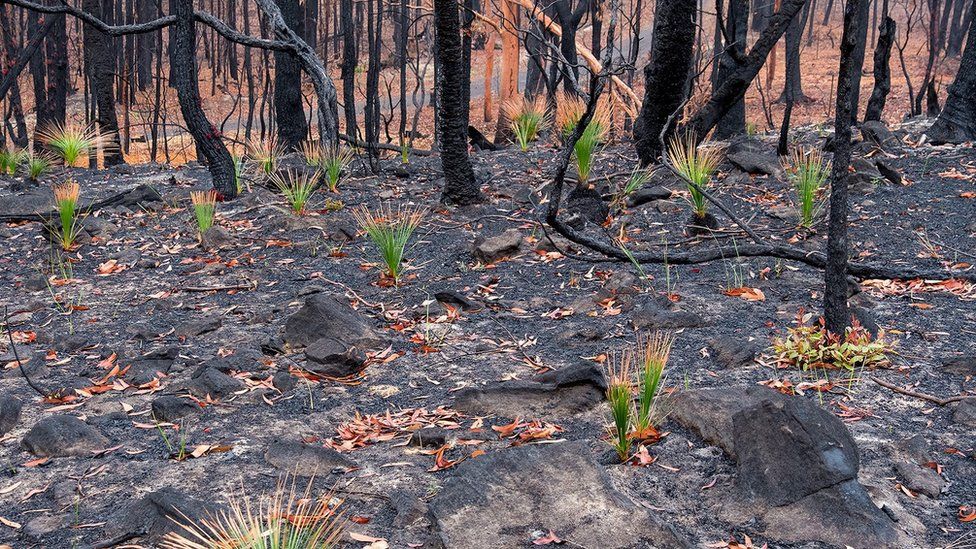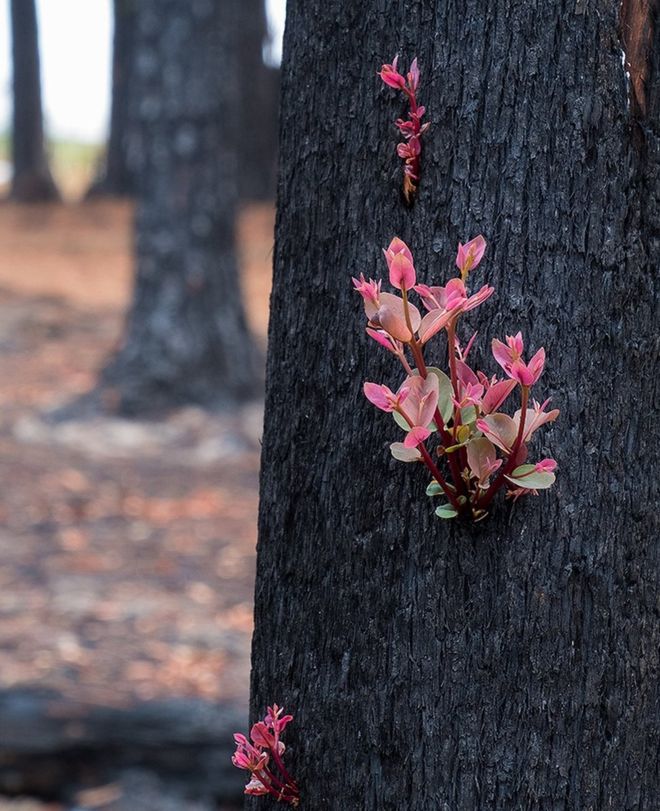澳大利亚火灾之后:植物在灰烬中再生
By Georgina Rannard
 Green grasses growing in parts of Kulnura which were on fire three weeks previously
Green grasses growing in parts of Kulnura which were on fire three weeks previously
The unprecedented bushfires sweeping parts of Australia have devastated huge areas of the country's natural environment.
At least half a billion animals and countless trees, plants and other living things have been killed since the fires began in September.
More than 6.3 million hectares (63,000 sq km or 15.6 million acres) have been burned so far - one hectare is roughly the size of a sports field.
But in some recently-burned areas, signs of life are returning, as captured by local photographer Murray Lowe, who went to investigate how fire had affected the bush near his home in Kulnura on Central Coast, New South Wales.
Walking on the grey ash, next to mobile phone masts downed by the fire that ravaged the area in late December, he found green grasses and rose-coloured leaves sprouting through burnt tree trunks.
The photos have been shared thousands of times on social media since Mr Lowe, who's 71, posted them on Monday, as people search for hope amid the devastation.
 Some plant species have evolved to re-sprout very quickly after fire
Some plant species have evolved to re-sprout very quickly after fire
A keen photographer, Mr Lowe wanted to document the fire-hit areas as a break from his "normal coastal sunrise images".
Driving through Kulnura, he stopped at the edge of Dhurag National Park, in a small residential community which largely survived the fire.
"The ground puffed up ash into the air from each footstep as we walked among the tree trunks in the eerie silence and stillness that only fires of this intensity can produce in aftermath," Mr Lowe, a retired vehicle inspector, explained.
Seeing the plants regrowing so quickly gave him hope, after witnessing what seemed like "total destruction".
"This was the sign of renewal we had been seeking. We were witnessing the rebirth of a forest that Australia is so well-known for," he said.
The 14,850 hectare Dhurag National Park, which remains closed due to fire threat, is home to several species only found in south-west Australia, including the gymea lily.
Is this recovery normal?
Yes - these plant species have experienced frequent fires for tens of millions of years. This has created an evolutionary pressure for them to develop the ability to recover after being burnt, explained Dr Kimberley Simpson, a fire ecology expert at the University of Sheffield.
Plants have evolved two ways of doing this.
The first is resprouting, which is clearly visible in the photographs, according to Dr Simpson.
Many Australian tree species, including most Eucalyptus species, have epicormics buds, which are set deep beneath thick bark and are insulated from intense heat. Many shrubs and grasses are also protected by fire by insulating layer of soil, meaning they can resprout quickly.
 Some species have buds deeply buried in bark, insulating them from intense heat
Some species have buds deeply buried in bark, insulating them from intense heat
The second way in which plant species recover quickly is through regeneration from heat-resistant seeds.
In fact, growth conditions are optimal after a fire for small seedlings, due to ample light and nutrients released from ash. Dr Simpson explained that it is "common to see a rapid greening of the ground after fire".
However, there is no evidence of this process in Mr Lowe's photographs, said Dr Simpson, because these seeds need rain to germinate and there has no been no rain in Kulnara since the fires.
Will this happen all over fire-hit Australia?
Regeneration after fire occurs over years - some species resprout soon after fire, and others take longer.
However, the size and severity of this season's fires "raise concerns about the survival of species that are adapted to fire", said Dr Simpson.
She said the high temperatures the fires are reaching, combined with the unprecedented drought in many parts of Australia, are likely to cause high plant mortality.
"We may see local extinctions in cases where species are pushed beyond their ability to recover," she suggested.
Particularly concerning is the impact of fire in Australia's rainforests, which don't normally experience fire, and are poorly equipped to recover after being burned.